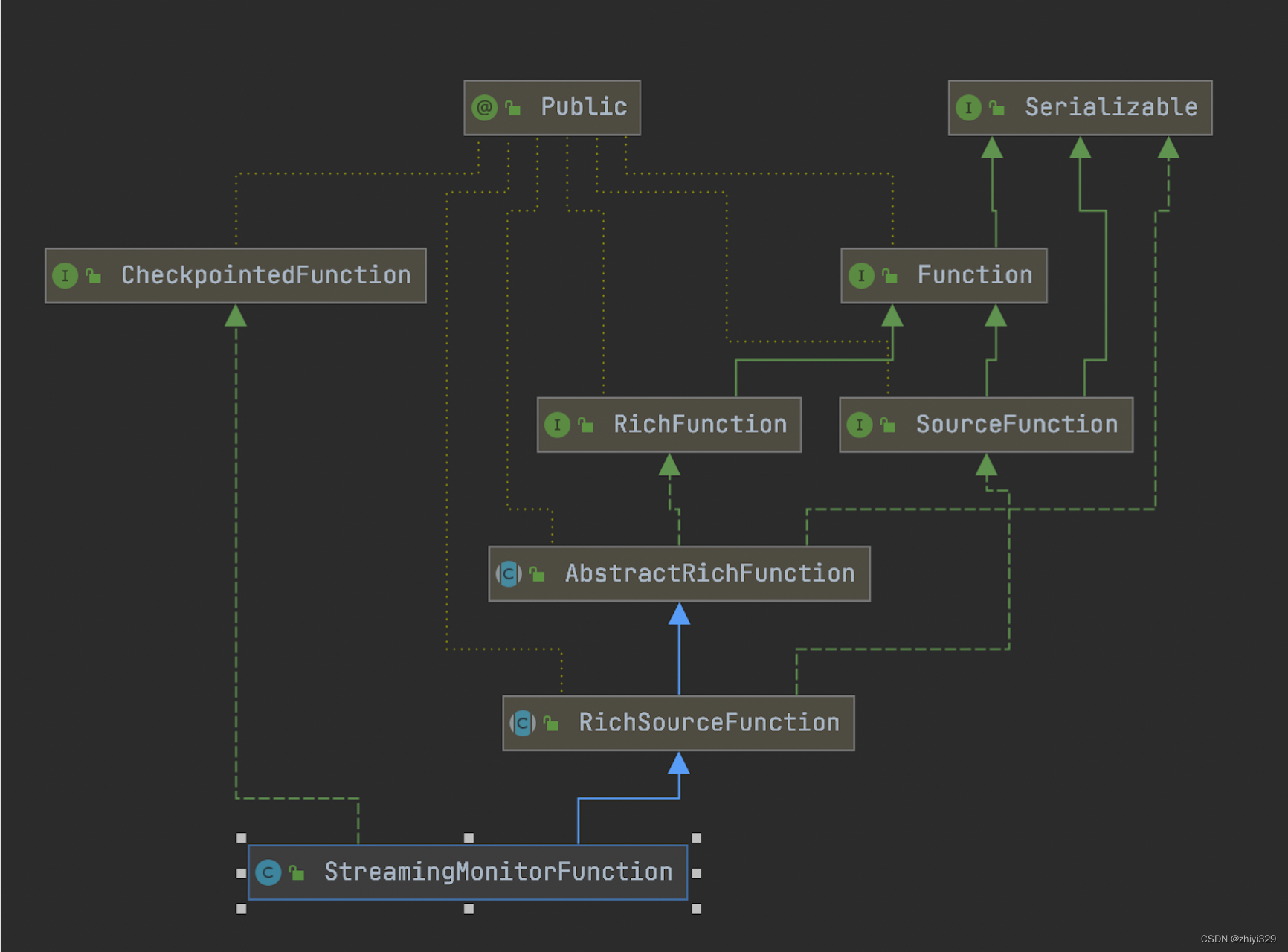Iceberg源码学习:flink读iceberg流程一
实例
StreamExecutionEnvironment env = StreamExecutionEnvironment.getExecutionEnvironment();
StreamExecutionEnvironment.createLocalEnvironment();
TableLoader tableLoader = TableLoader.fromHadoopTable("XXX");
DataStream<RowData> stream = FlinkSource.forRowData()
.env(env)
.tableLoader(tableLoader)
.streaming(true)
.build();
stream.print();
env.execute("IcebergRead");
流程详解
首先看build()方法:
public DataStream<RowData> build() {
Preconditions.checkNotNull(this.env, "StreamExecutionEnvironment should not be null");
FlinkInputFormat format = this.buildFormat();
ScanContext context = this.contextBuilder.build();
TypeInformation<RowData> typeInfo = FlinkCompatibilityUtil.toTypeInfo(FlinkSchemaUtil.convert(context.project()));
if (!context.isStreaming()) {
int parallelism = this.inferParallelism(format, context);
if (this.env.getMaxParallelism() > 0) {
parallelism = Math.min(parallelism, this.env.getMaxParallelism());
}
return this.env.createInput(format, typeInfo).setParallelism(parallelism);
} else {
StreamingMonitorFunction function = new StreamingMonitorFunction(this.tableLoader, context);
String monitorFunctionName = String.format("Iceberg table (%s) monitor", this.table);
String readerOperatorName = String.format("Iceberg table (%s) reader", this.table);
return this.env.addSource(function, monitorFunctionName).transform(readerOperatorName, typeInfo, StreamingReaderOperator.factory(format));
}
}
该方法主要做了两件事情:
-
利用tableLoader加载对应的table,然后通过这个table获取到对应的FileIO、Schema、EncryptionManager、ScanContext对象,然后分两种情况,批读取和流读取
-
在流式读取情况下,将DataSourceStreamingMonitorFunction和StreamingReaderOperator蒜子注册到env上
StreamingMonitorFunction:不停的扫描iceberg表看是否有新的snapshot生成,如果有则生成CombinedScanTask发向下游。
StreamingReaderOperator:一旦收到source发来的split,会将其放到一个队列中,然后通过一个MailboxExecutor线程处理,这种结构可以将读取数据和处理checkpoint barriers功能分离,避免潜在的背压。
StreamingMonitorFunction
继承关系:

它实现了CheckpointedFunction接口,所以能够保证在source端的一致性;
另外,因为它并没有实现ParallelSourceFunction接口,所以它注定只能有一个并行度。这里的目的是确保在只有一个线程去监控Iceberg表和分发任务,多线程只会发生数据错乱。
run()方法流程:
public void run(SourceFunction.SourceContext<FlinkInputSplit> ctx) throws Exception {
this.sourceContext = ctx;
while(this.isRunning) {
this.monitorAndForwardSplits();
Thread.sleep(this.scanContext.monitorInterval().toMillis());
}
}
monitorAndForwardSplits()方法,获取表当前最新的快照snapshotId,如果记录了lastSnapshotId,那就生成lastSnapshotId到snapshotId之间的增量文件的FlinkInputSplit对象:
void monitorAndForwardSplits() {
this.table.refresh();
Snapshot snapshot = this.table.currentSnapshot();
if (snapshot != null && snapshot.snapshotId() != this.lastSnapshotId) {
long snapshotId = snapshot.snapshotId();
ScanContext newScanContext;
if (this.lastSnapshotId == -1L) {
newScanContext = this.scanContext.copyWithSnapshotId(snapshotId);
} else {
snapshotId = this.toSnapshotIdInclusive(this.lastSnapshotId, snapshotId, this.scanContext.maxPlanningSnapshotCount());
newScanContext = this.scanContext.copyWithAppendsBetween(this.lastSnapshotId, snapshotId);
}
LOG.debug("Start discovering splits from {} (exclusive) to {} (inclusive)", this.lastSnapshotId, snapshotId);
long start = System.currentTimeMillis();
FlinkInputSplit[] splits = FlinkSplitPlanner.planInputSplits(this.table, newScanContext, this.workerPool);
LOG.debug("Discovered {} splits, time elapsed {}ms", splits.length, System.currentTimeMillis() - start);
start = System.currentTimeMillis();
synchronized(this.sourceContext.getCheckpointLock()) {
FlinkInputSplit[] var9 = splits;
int var10 = splits.length;
int var11 = 0;
while(true) {
if (var11 >= var10) {
this.lastSnapshotId = snapshotId;
break;
}
FlinkInputSplit split = var9[var11];
this.sourceContext.collect(split);
++var11;
}
}
LOG.debug("Forwarded {} splits, time elapsed {}ms", splits.length, System.currentTimeMillis() - start);
}
}
此处核心:
- 构造出从startSnapshotId到snapshotId之间的增量FlinkInputSplit(FlinkSplitPlanner.planInputSplits为核心内容,流程二详细讲解)
- 将FlinkInputSplit分配给下游进一步的处理
StreamingReaderOperator
继承关系:

一些参数:
private final MailboxExecutor executor;
private FlinkInputFormat format;
private transient SourceFunction.SourceContext<RowData> sourceContext;
private transient ListState<FlinkInputSplit> inputSplitsState;
private transient Queue<FlinkInputSplit> splits;
private transient SplitState currentSplitState;
其中:
- executor是暴露出来的一个执行器,这个线程同时处理用户操作和checkpoint动作,我们一次只预定一个InputSplit去读取,因此当新的checkpoint到达是能被触发而不是被InputSplit读取操作阻塞。
- inputSplitsState为存储FlinkInputSplit的状态变量,即需要被读取的FlinkInputSplit,会在checkpoint持久化。
- splits为当前周期需要读取的FlinkInputSplit,会在initializeState从inputSplitsState读出来。
- currentSplitState表示当前的读取状态。
处理数据流程:
public void processElement(StreamRecord<FlinkInputSplit> element) {
this.splits.add((FlinkInputSplit)element.getValue());
this.enqueueProcessSplits();
}
将接收到的数据加入splits然后调用enqueueProcessSplits方法
private void enqueueProcessSplits() {
if (this.currentSplitState == StreamingReaderOperator.SplitState.IDLE && !this.splits.isEmpty()) {
this.currentSplitState = StreamingReaderOperator.SplitState.RUNNING;
this.executor.execute(this::processSplits, this.getClass().getSimpleName());
}
}
在executor中异步的执行了如下操作:
- 从列表头中取出一个FlinkInputSplit对象,调用FlinkInputFormat.open()
- 轮询调用FlinkInputFormat.nextRecord()获取RowData数据对象,并交给了flink的SourceContext,至此数据真正的进入了流
一直循环1-2这个过程,直到队列为空。
private void processSplits() throws IOException {
FlinkInputSplit split = (FlinkInputSplit)this.splits.poll();
if (split == null) {
this.currentSplitState = StreamingReaderOperator.SplitState.IDLE;
} else {
this.format.open(split);
try {
RowData nextElement = null;
while(!this.format.reachedEnd()) {
nextElement = this.format.nextRecord(nextElement);
this.sourceContext.collect(nextElement);
}
} finally {
this.currentSplitState = StreamingReaderOperator.SplitState.IDLE;
this.format.close();
}
this.enqueueProcessSplits();
}
}
StreamingReaderOperator中有一个成员变量为FlinkInputFormat format,FlinkInputFormat继承自flink中的RichInputFormat,RichInputFormat继承自InputFormat,InputFormat为读取数据时候的一个抽象类,一些数据的读取数据的相关类都基于它实现。
format的open()方法会去构建一个RowDataIterator对象,RowDataIterator对应一个CombinedScanTask的数据读取的迭代器:
public void open(FlinkInputSplit split) {
this.iterator = new DataIterator(this.rowDataReader, split.getTask(), this.io, this.encryption);
}
nextRecord()方法获取下一个元素:
public RowData nextRecord(RowData reuse) {
++this.currentReadCount;
return (RowData)this.iterator.next();
}
进入DataIterator.next():
public T next() {
this.updateCurrentIterator();
++this.recordOffset;
return this.currentIterator.next();
}
private void updateCurrentIterator() {
try {
while(!this.currentIterator.hasNext() && this.tasks.hasNext()) {
this.currentIterator.close();
this.currentIterator = this.openTaskIterator((FileScanTask)this.tasks.next());
++this.fileOffset;
this.recordOffset = 0L;
}
} catch (IOException var2) {
throw new UncheckedIOException(var2);
}
}
private CloseableIterator<T> openTaskIterator(FileScanTask scanTask) {
return this.fileScanTaskReader.open(scanTask, this.inputFilesDecryptor);
}
updateCurrentIterator()函数轮询了CombinedScanTask中的Collection files(),针对每个FileScanTask执行了FileScanTaskReader的fileScanTaskReader.open(scanTask, inputFilesDecryptor),通过FileScanTask任务读取了RowData对象,读取底层文件,包括PARQUET、AVRO、ORC三种文件格式的读取。
